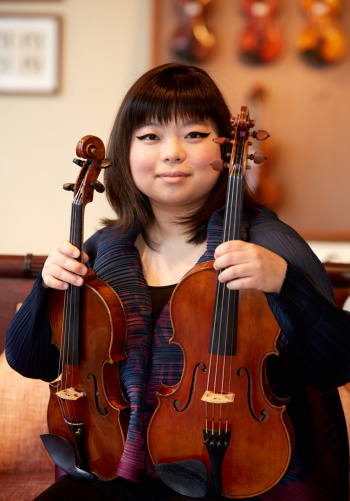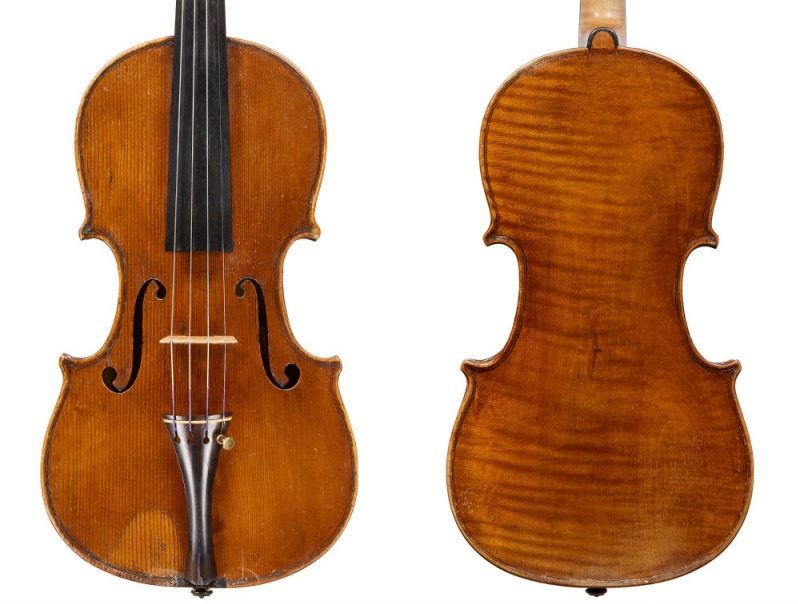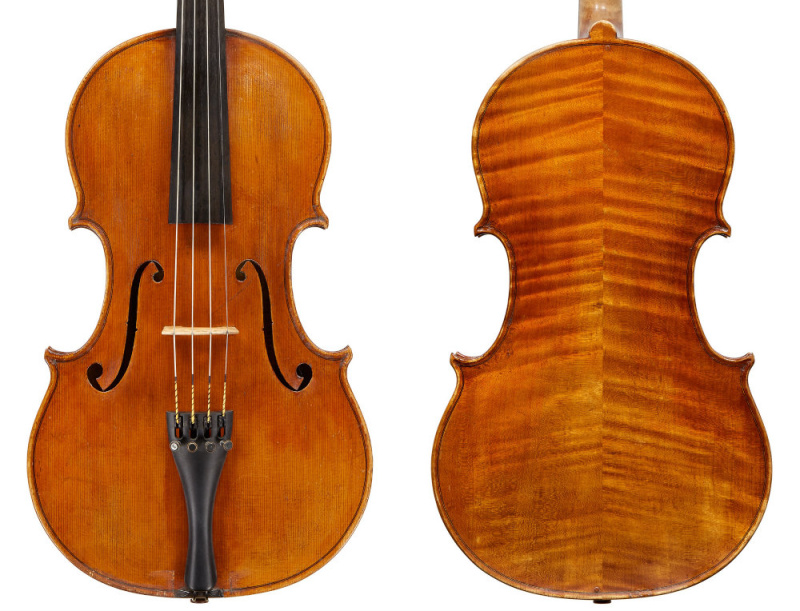
Yura Lee with her Gagliano violin and Douglas Cox viola. Photo: Robert Bailey, Tarisio
I am looking for a very specific sound. I want my violin to sound like a viola and my viola to sound like a cello. I’ve always loved the cello and piano – their ability to encompass the bass, middle and harmony. The violin can be quite limiting from this point of view, so it’s interesting to focus on something other than the brilliance of sound and the virtuosity of the instrument.
I was using a Joseph and Antonio Gagliano violin and before that had a Guarneri ‘del Gesù’ on loan. I had been searching for a long time for my own instrument. In my third year of looking I picked up my Raffaele and Antonio Gagliano at auction and something clicked. It gave me a sense of possibility that I hadn’t found in any other instrument. It wasn’t the most expensive instrument in the auction, or the best looking, or in the best condition, but when you know, you know – and I knew. Because I have a strong sense of what I want, I usually know within 20 seconds, even with a bow. Some might say I’m not careful enough and that some instruments only feel right after you’ve played them a long time, but I’m not looking for a difficult person that I can conform to my needs over three years. What I’m looking for in my sound is difficult enough, so I’m looking for a partner.
I like instruments that give me an infinite amount of vibrations, so I can be in control of where the firmness of the sound stops. I don’t want to rely on a pre-decided place where I know that the sound is going to project the most. When you first hear my Gagliano it may sound a little hollow, and it’s difficult to gauge how much you can push it, but I know how my body reacts to it and what my body wants to do. If I make it brilliant at the top then it has brilliance, but only if I make it that way. That’s what I love about this instrument: if I don’t force it then it doesn’t force me. People ask me how such a dark-sounding violin works in concertos, but it’s not about dark or light, it’s how you work with the vibrations of the sound, focusing it or making the quality more or less dense according to the situation.
When I try an instrument I try the G string first, although when I hear other people they always try the E string first. You can always make an instrument scream like that if you want it to, but you can’t always make it give you a hug, so I look for that first. I like to play a simple scale, to be neutral. The first line of the Bruch or Tchaikovsky concertos are good vehicles. If it responds at the bottom it usually responds at the top, and you immediately know.

Lee found her c. 1831 Rafael and Antonio Gagliano violin at auction in 2012. ‘It gave me a sense of possibility that I hadn’t found in any other instrument,’ she says. Photos: Robert Bailey, Tarisio
![]()
If we’ve chosen our instrument carefully and it lets us down, it’s not always the instrument’s fault. We go through many changes in a day: sometimes we feel good and sometimes we don’t, and we don’t always know why. Instruments are the same. They go through climate changes and they’re not always happy. Sometimes the instrument and the performer aren’t happy at the same time. But if you can’t change the situation of the instrument, why not change your mindset? If you face a difficulty in playing you can learn another way of doing something, which is another tool in your toolbox.
Sometimes the peculiarities of an instrument become your favorite aspect. The top of my Gagliano has wide grain on the left side and very narrow grain on the right side, but now it’s my favorite part. Conversely, sometimes the thing you like most can become annoying. For example, my Gagliano almost never gets sick and sometimes I wish that it would be a bit finicky so I could work with it more. It’s almost too stable.
I have always looked for the complete musical feeling, not just singing, beautiful lines. I became very interested in the sound of the cello and I started the viola because I wanted to play cello music. Then I realised a whole other dimension of the instrument – you have the freedom of lightness, but if you want you can sink into the sound as cellists would.
I met my viola at the Marlboro Music Festival. I didn’t know what I was looking for – I just knew I wanted something that felt right physically. I’m one of the smallest people I know who plays the viola and I needed it to be comfortable. Douglas Cox brought in a selection of ten or so of his instruments and, again, I knew as soon as I picked it up that it was right. I was able to create the sound on it that I wanted.

Lee plays a 15 5/8-inch Douglas Cox viola from 2002. ‘The goal is to create a small feel for the player with as much acoustic size as possible,’ says Cox. Photos: Robert Bailey, Tarisio
![]()
It’s 15 5/8 inches and is narrow at the top and a bit wider at the bottom, which means that I can reach the top without getting stuck at the belly. It’s quite similar to my violin in that it’s limitless: I choose the limits. I have to really support the sound I want on the C string, but if I want it to sound like a cello and not a viola it can do that. I wasn’t looking for the deepest C string sound or the most brilliant A string sound, but it does give me both when I know how to get them. It doesn’t offer me ease of playing but I’m not looking for that – I’m looking for something complex and interesting.
There’s no challenge in switching between violin and viola, because I become a different person. Many people think of the viola as a big violin, but it isn’t. You have to use different muscles and to ask for sound in a different way. You cannot control the viola in the same way you can control the violin. You can force a violin to do something and be very egotistical and it will still respond. I find with many violas, including mine, you almost have to plead with it to make it sound with you. I don’t find it hard to switch back and forth because I want to be the vehicle to express two different kinds of personality. It’s not about me, it’s about the music and the instrument. I love both characters and I love going back and forth.
Douglas Cox on Yura Lee’s viola
I built the viola in 2002 on a model I developed in 1988. Its 15 5/8-inch body length and 14-inch string length make it easy to get around. The upper bouts are narrow (186 mm) relative to the lower bouts (241 mm) and the ribs at 37 mm are proportionally a bit high to add more air volume. The goal is to create a small feel for the player with as much acoustic size as possible. The arching and f-holes are late Guarneri and create a tone colour that is dark, with a bit of grit, broad but not hollow.
The wood is New England grown, the maple cut in the western White Mountains of New Hampshire in 1983 and the spruce in northern Maine in 1981. It is wood I cut from the log and have used extensively.
Ariane Todes was formerly editor of The Strad magazine and is now a freelance writer and editor.